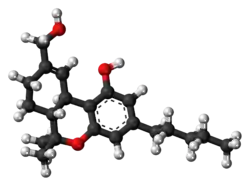11-Hydroxy-THC
11-Hydroxy-Δ9-tetrahydrocannabinol (11-OH-THC), usually referred to as 11-hydroxy-THC, is the main active metabolite of tetrahydrocannabinol (THC), which is formed in the body after decarboxylated cannabis is consumed.[1][2]
 | |
 | |
| Identifiers | |
|---|---|
| |
| CAS Number | |
| PubChem CID | |
| ChemSpider | |
| UNII | |
| CompTox Dashboard (EPA) | |
| ECHA InfoCard | 100.164.583 |
| Chemical and physical data | |
| Formula | C21H30O3 |
| Molar mass | 330.468 g·mol−1 |
| 3D model (JSmol) | |
| |
| |
| | |
Fresh cannabis contains tetrahydrocannabinolic acid (THCA), which is converted into THC after heating and then metabolized by the body into 11-hydroxy-THC and then into 11-nor-9-carboxy-THC;[2] both compounds can be glucuronidated and mainly excreted into urine. Both compounds, along with THC, are assayed in blood tests.[1]
See also
References
- Kraemer T, Paul LD (August 2007). "Bioanalytical procedures for determination of drugs of abuse in blood". Analytical and Bioanalytical Chemistry. 388 (7): 1415–35. doi:10.1007/s00216-007-1271-6. PMID 17468860. S2CID 32917584.
- Huestis MA (2005). "Pharmacokinetics and metabolism of the plant cannabinoids, delta9-tetrahydrocannabinol, cannabidiol and cannabinol". Handbook of Experimental Pharmacology. 168 (168): 657–90. doi:10.1007/3-540-26573-2_23. ISBN 3-540-22565-X. PMID 16596792.
This article is issued from Wikipedia. The text is licensed under Creative Commons - Attribution - Sharealike. Additional terms may apply for the media files.